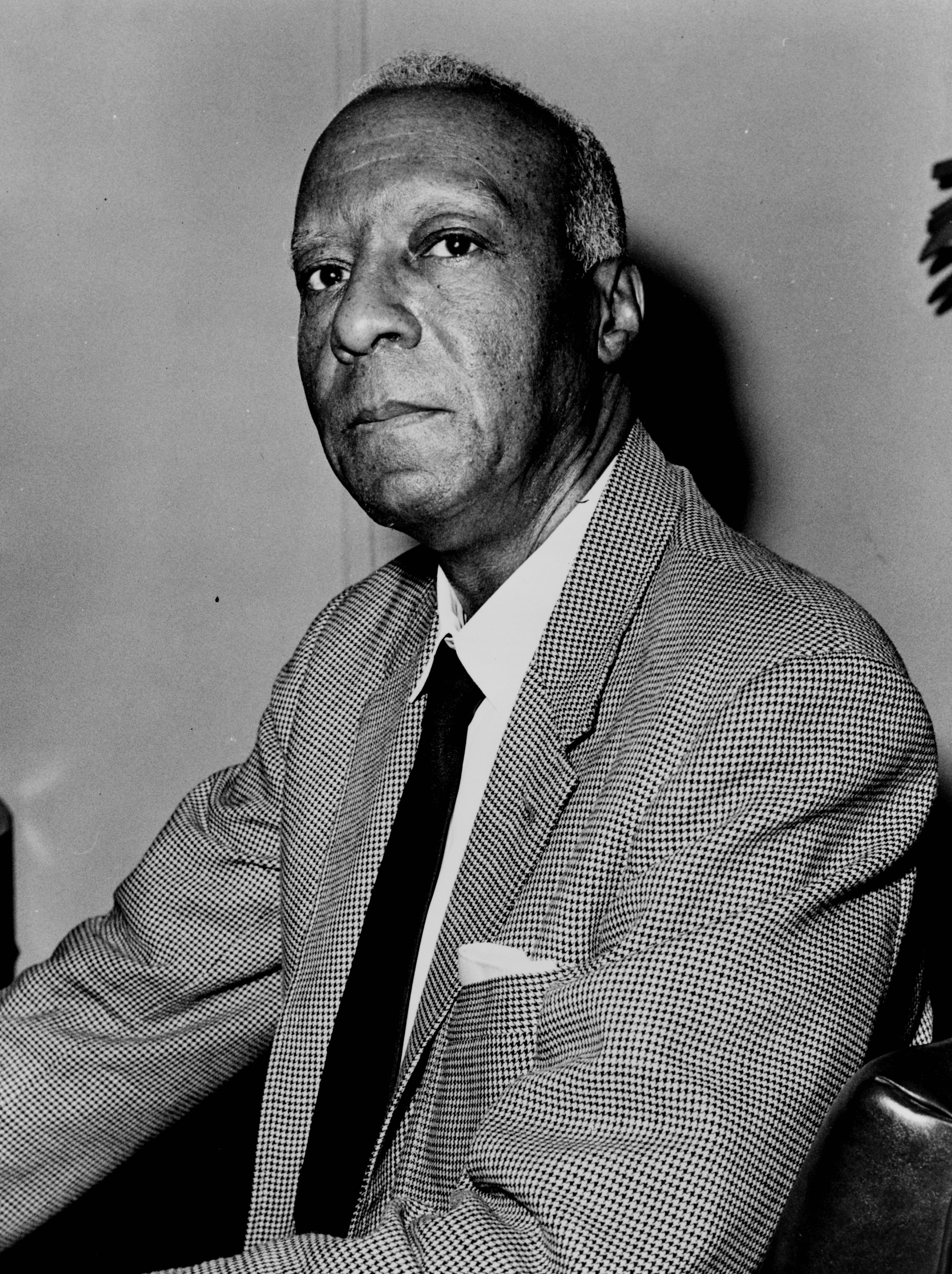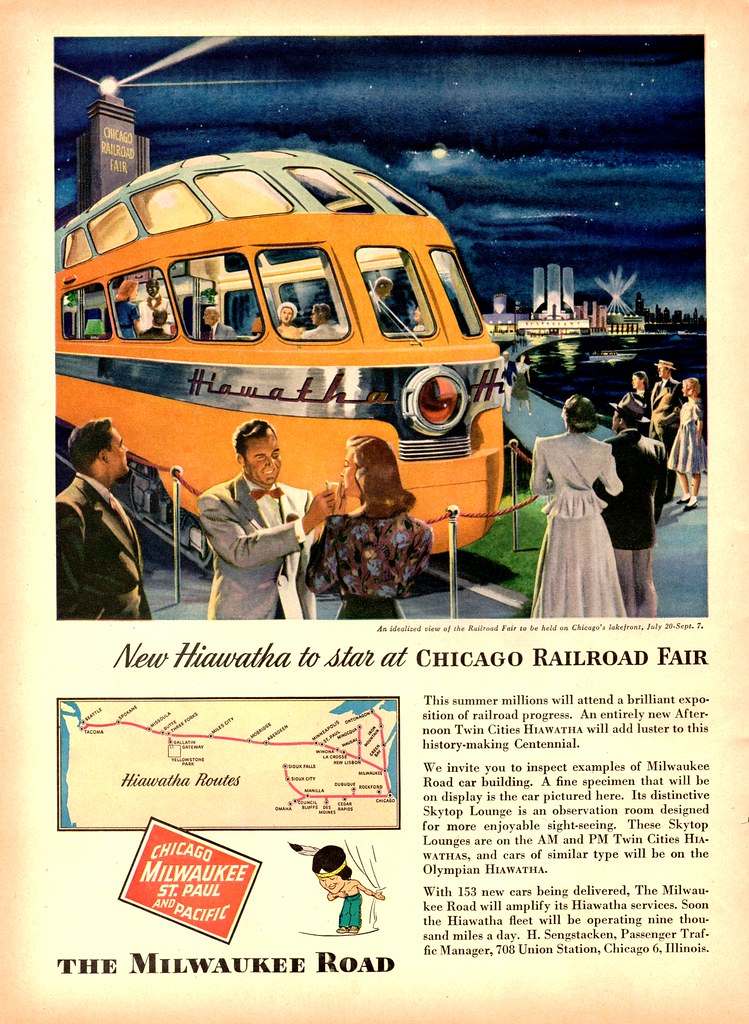
On August 10, 1953 the entire crew of the Milwaukee Road night train posed in front of their Skytop Lounge car in Tacoma. Tacoma was the western terminus for the Milwaukee Road, the only one of four transcontinental lines into the city that had its own passenger depot and freight house. The others, the Northern Pacific, Union Pacific and Great Northern, all shared Union Station.
The layers of information about post war America captured in this photograph on a warm summer day, make it a fascinating, strangely bittersweet, historical document that wanders into issues of race, social status, gender, age, changing transportation technology and the dying days of transcontinental rail service.
Americans were traveling more in the years following World War Two but increasingly their journeys took them away from the aging technology and fading romance of rail service. Automobiles, buses and airplanes were leaving the railroads behind and with them people like this who were tied to the railroad’s old ways and aging conventions of class and privilege.
In the world of railroad travel the dress coding is not at all subtle. The African American porters, waiters and kitchen staff all wear whites while the conductors and barman are all in dark. The engineers wear the traditional gray coveralls and caps that carried over from the days of steam engines and coal dust. Everyone wears a tie or high collar except the kitchen staff who wear crisp chef’s tunics and caps in the European culinary tradition. Working for the railroad was like being in the service where uniforms reflected work specialty, seniority and pay grade.
The standing, older conductors are uniformed in military styled caps, vests and pocket watches. There is a clear message in the conductor’s cap about high rank and authority on board, a message understood by passengers and employees alike. The conductors on this crew are all near the end of their working careers, as are the engineers and senior porters, men in their late 50’s and 60’s that have crossed the country on rail countless times, watched the miles and years go by at ground level and listened to the soundtrack of rhythmic steel wheels, train whistles and boarding calls.
The men in the front row worked in the dining cars, lounges and kitchens. These were skilled middle class jobs for the African Americans who dominated the profession on all of America’s railroads. In the mix of old and young men their is a quiet sense of competence and confidence in the work they do. Working the night trains from Chicago to Tacoma and the west coast meant long trips from home, little sleep and no pay on the deadhead runs between destinations. Working 400 hours some months, the pay checks were relatively small but cash tips and pension benefits made the work rewarding for many African Americans.
The Civil Rights Act of 1964 was still a decade in the future when this photo was taken but everyone on this crew knew about the achievements of the Brotherhood of Sleeping Car Porters (BSCP) in becoming the first African American

labor organization to join the American Federation of Labor in 1925. The BSCP grew from a Chicago base led by A. Philip Randolph , the civil rights pioneer who worked to end discrimination in the defense industries during World War Two and then the end of segregation in the military in 1948. In 1963, Randolph was the head of the March on Washington where Martin Luther King Jr. gave his “I Have a Dream” speech.
Tacoma’s place as a west coast terminal city for several cross country railroads running out of Chicago made it a home base for many black families beginning in the late 19th Century. In Tacoma, black railroad families owned their own homes mostly in the K Street (Martin Luther King Jr Way) and central districts, supported their busy churches and social clubs and provided a cultural base for African American newcomers.
Following the Philip Randolph led BSCP’s contract settlement with the Pullman Company in 1937, earning black railroad employees shorter work weeks, overtime pay and $2 million in wage increases, Tacoma’s black population grew steadily, though it remained less than 700 residents in the 1940 U.S. census. But with the growing threat of war, Randolph and other black labor leaders began pressing President Roosevelt to prohibit racial discrimination in the defense industries including railroads. As the growing threat of war closed in, FDR issued an executive order in June 1941 prohibiting racial or ethnic preferences in wartime employment. By the end of the year America was at war and the Pacific Coast became an important front after the attack on Pearl Harbor.
Tacoma like Seattle and Bremerton needed workers to rebuild the Pacific fleet and produce military aircraft and Fort Lewis became a major destination for new soldiers. Chicago and the population centers of the mid west and South became rich recruitment grounds for the war effort and free train tickets for men and their families gave African Americans a chance to defend their country and make a new start at the same time. By 1943 Tacoma’s black population neared 10,000 people including families that quickly filled up new wartime worker housing at Salishan on the east side.
Most folks came by railroad arriving at Union Station during its last great wave of travelers through the rotunda during the war. Many black families and veterans stayed after the war and following desegregation in the U.S. Army in 1948 more Korean War era African American families settled in Tacoma and the south sound. They soon outnumbered the black pioneers that came with the railroad in the generations before.
But back to 1953 and our group photograph and the changing times for America’s railroads. The proud portrait of the night train crew is oddly posed in front of the back end of the train because that was where the innovation and newness was in passenger travel by train. Railroads were being chased by airplanes when it came to distance travel at mid-century and they were losing. Transcontinental journeys were taking wings and this time it was from the west coast to the east. Boeing in the Pacific Northwest and Lockheed in Los Angeles were transforming from military aircraft producers into commercial airplane manufactures for airlines like United and TWA. For a time, the railroads tried to outrun the inevitable, mimicking the aerodynamic styling of their airborne competitors, copying the uniforms and even falling to pre-cooked meals on TV trays instead of dining cars with table cloths and napkins. This photograph captures all of it. Gazing back into it as history, its a portrait of hard working people with the end of a era and a livelihood right behind them.





In 1954, I was 8 years old. Our family, 5 kids, moved from Los Angeles to New York by train. We went in a Pullman car. After almost 60 years I still remember the name of the porter assigned to our car, Mister Grandy. He was the kindest man. My mom was alone with 5 kids ranging in age from 9 to 12 months. Mister Grandy took us on tours of the train and gave her a few moments of rest. When we got to Chicago he took me and my brothers up to the locomotive. Amazing how a few moments of kindness will make an indelible mark on a person’s memory.
LikeLike
I hope folks read your story Jim. History is so much about stories like this, about human experiences and acts of kindness and generosity. Thanks for taking the time to comment.
LikeLike
My Great Grandfather, Louis Wick, came from Oslo, Norway, in 1904. He came to work for the Burlington Northern Railway as a Bridge Builder Supervisor for 50 years raising 8 children. He passed at age 87 in the Burlington Northern Hospital which was a large brick building on McKinley Ave. and E. Wright St.
LikeLike
My paternal grandfather, Bill Crossman, was an engineer for the Milwaukee Road. In May of 1961, at the controls of a train coming down from Snoqualmie Pass, he had a heart attack. He was found dead at age 59, as the train reached the lower elevation.
LikeLike